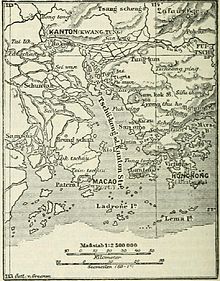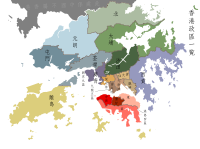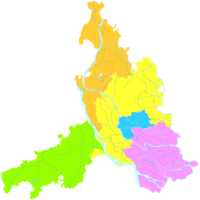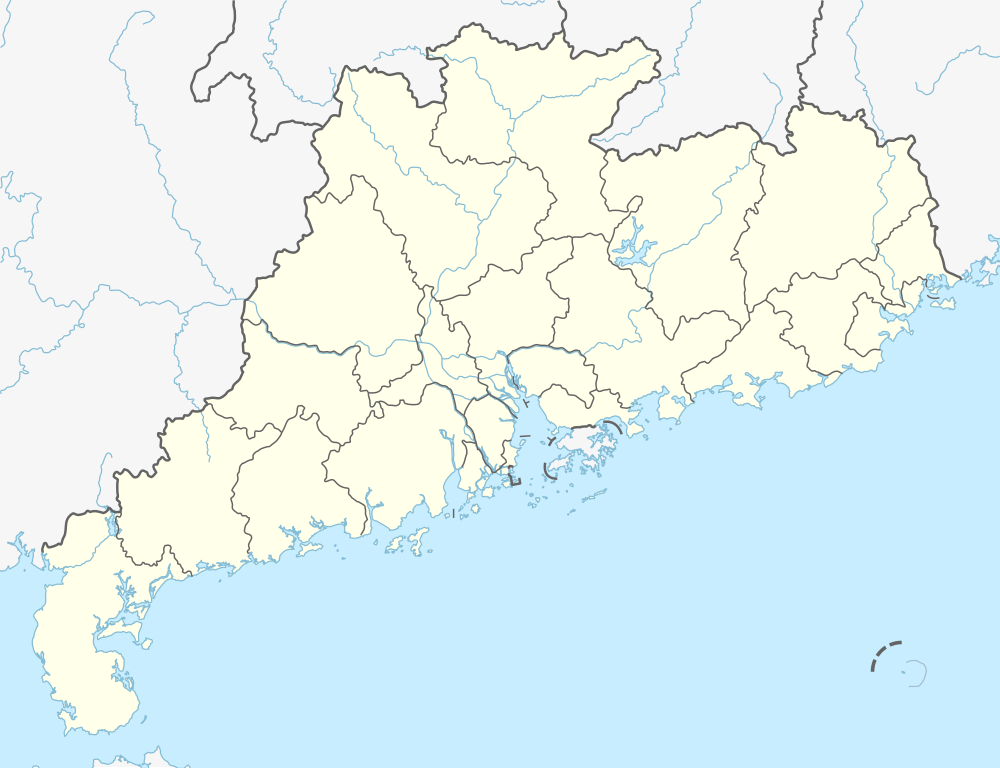Pearl River Delta
Pearl River Delta
珠江三角洲 | |
|---|---|
 Map of Pearl River Delta in Green | |
| Country / SAR | |
| Major Cities | Guangzhou Shenzhen Hong Kong Huizhou Dongguan Foshan Jiangmen Zhongshan Zhuhai Macau |
| Government | |
| • Governor of Guangdong | Zhu Xiaodan |
| • Chief Executive of Hong Kong | CY Leung |
| • Chief Executive of Macau | Fernando Chui
|
| Area | |
| • Metro | 39,380 km2 (15,200 sq mi) |
| Population | |
| • Metro | 63,724,157−120,000,000 |
| Time zone | UTC+8 (CST, HKT, MST) |
| Pearl River Delta | |||||||||||||
|---|---|---|---|---|---|---|---|---|---|---|---|---|---|
| Chinese | 珠江三角洲 | ||||||||||||
| Jyutping | Zyu1gong1 Saam1gok3zau1 | ||||||||||||
| Cantonese Yale | Jyūgōng Sāamgokjāu | ||||||||||||
| Hanyu Pinyin | Zhūjiāng Sānjiǎozhōu | ||||||||||||
| |||||||||||||
The Pearl River Delta (PRD, Chinese: 珠江三角洲; pinyin: Zhūjiāng sānjiǎozhōu; Jyutping: zyu1 gong1 saam1 gok3 zau1), Zhujiang Delta or Zhusanjiao in Guangdong province, People's Republic of China is the low-lying area surrounding the Pearl River estuary where the Pearl River flows into the South China Sea. It is one of the most densely urbanised regions in the world and one of the main hubs of China's economic growth. This region is often considered an emerging megacity. The PRD is not a megalopolis but rather one rapidly forming megacity, and itself the southern end of a larger megalopolis running along the southern coast of China, which include large metropolises like Chaoshan, Zhangzhou-Xiamen, Quanzhou-Putian, and Fuzhou.
Historical background
Since economic liberalisation was adopted by the Chinese government in the late 1970s, the delta has become one of the leading economic regions and a major manufacturing center of China and the world. The Chinese government hopes that the manufacturing in Guangdong, combined with the financial and service economy and traditional capitalistic influence in Hong Kong, will create an economic gateway attracting foreign capital throughout mainland China.
Geography
River delta
The river delta, also known as the Golden Delta of Guangdong,[1] is formed by three major rivers, the Xi Jiang (West River), Bei Jiang (North River), and Dong Jiang (East River). The flat lands of the delta are criss-crossed by a network of tributaries and distributaries of the Pearl River. The Pearl River Delta is actually two alluvial deltas, separated by the core branch of the Pearl River. The Bei Jiang and Xi Jiang converge to flow into the South China Sea and Pearl River in the west, while the Dong Jiang only flows into the Pearl River proper in the east.
The Xi Jiang begins exhibiting delta-like characteristics as far west as Zhaoqing, although this city is not usually considered a part of the PRD region. After passing through the Lingyang Gorge and converging with the Bei Jiang, the Xi Jiang opens up and flows as far east as Nasha Qu and as far west as Xinhui. Major distributaries of the Xi include Donghui Shuidao, Jiya Shuidao, Hutiaomen Shuidao, Yinzhou Hu, and the main branch of the Xi Jiang. Jiangmen and Zhongshan are the major cities found in the western section of the delta.
The Bei Jiang enters the delta plains at Qingyuan but doesn't begin to split until near Sanshui. From here the two main distributaries are Tanzhou Shuidao and Shunde Shuidao which form multiple mouths along the west side of the Pearl River's estuary. Two other distributaries, Lubao Yong and Xinan Yong, split from the Bei further north and converge with the Liuxi He to form the main branch of the Pearl River just north of Guangzhou. The other major city in the north section of the delta is Foshan.
The Dong Jiang flows through Huizhou into the delta. It begins diverging northeast of Dongguan into many distributaries, including the Dongguan Shuidao. Distributuares enter the Pearl River as far north as Luogang and as far south as Hu Men (Tiger Gate).
Location and demographics
As well as the delta itself, the term Pearl River Delta refers to the dense network of cities that covers nine prefectures of the province of Guangdong, namely Guangzhou, Shenzhen, Zhuhai, Dongguan, Zhongshan, Foshan, Huizhou, Jiangmen and Zhaoqing, and the SARs of Hong Kong and Macau. The 2010/2011 State of the World Cities report, published by the United Nations Human Settlements Programme, estimates the population of the delta region at 120 million people; it is rapidly urbanising.[2]
The eastern side of the PRD (Shenzhen, Dongguan), dominated by foreign capitals, is the most developed economically. The western areas (Foshan, Zhuhai, Zhongshan, Jiangmen), dominated by local private capitals, are open for development. New transport links between Hong Kong, Macau and Zhuhai in the PRD are expected to open up new areas for development, further integrate the cities, and facilitate trade within the region. The proposed 50-kilometre Hong Kong-Zhuhai-Macau Bridge will be the longest in the world.

Until c. 1985, the PRD had been mainly dominated by farms and small rural villages, but after the economy was reformed and opened, a flood of investment turned it into the land's economic powerhouse. The PRD's startling growth was fueled by foreign investment coming largely from Hong Kong manufacturers that moved their operations into the PRD. In 2003, Hong Kong companies employed 11 million workers in their PRD operations. Lately there have been extreme labour shortages in the region due to runaway economic growth which caused wages to rise by about 20 to 30 percent in the past two years.[3]
Economy
The Pearl River Delta has been one of most economically dynamic regions of the People's Republic of China since the launch of China’s reform programme in 1979. With annual gross domestic product growth of 13.45 percent over three decades since 1978, it is 3.5 percentage points higher than the national average. Since 1978, almost 30% of all foreign investment in China was in the PRD.[4] By 2007 its GDP rose to US$448 billion which makes its economy about the size of Taiwan's.[5] The abundance of employment opportunities created a pool of wealthy, middle-income, professional consumers with an annual per capita income that puts them among China's wealthiest.[6] Since the onset of China’s reform program, the Pearl River Delta Economic Zone has been the fastest growing portion of the fastest growing province in the fastest growing large economy in the world.[7]
According to the 2000 national Census, the Zone had a population of 40.8 million people. Per capita income has been growing substantially in recent years, as have consumer expenditures.
Although the Pearl River Delta Economic Zone encompasses only 0.4 percent of the land area and only 3.2 percent of the 2000 Census population of mainland China, it accounted for 8.7 percent of GDP, 35.8 percent of total trade, and 29.2 percent of utilised foreign capital in 2001. These figures show the remarkable level of economic development that the Pearl River Delta Economic Zone has achieved and the international orientation of the region’s economy. This orientation has attracted numerous investors from all over the world who use the Greater Pearl River Delta region as a platform for serving global and Chinese markets.
As of 2008, the Central Government has introduced new labor laws, environmental and new regulations to reduce pollution, industrial disputes, safer working conditions and protect the environment. The costs of producing low margin and commodity goods have increased. This is on top of the rising cost for energy, food, transport and the appreciation of the Renminbi against the falling US Dollar. Some manufacturers will need to cut costs by moving up the value chain or moving to more undeveloped regions.[8]
Significance of manufacturing

The Pearl River Delta has become the world's workshop and is a major manufacturing base for products such as electronic products (such as watches and clocks), toys, garments and textiles, plastic products, and a range of other goods. Much of this output is invested by foreign entities and is geared for the export market. The Pearl River Delta Economic Zone accounts for approximately one third of China's trade value.
Private-owned enterprises have developed quickly in the Pearl River Delta Economic Zone and are playing an ever-growing role in the region's economy, particularly after year 2000 when the development environment for private-owned enterprises has been greatly relaxed.
Nearly five percent of the world's goods were produced in the Greater Pearl River Delta in 2001, with a total export value of US$ 289 billion. Over 70,000 Hong Kong companies have plants there.[8]
Map (with links)
| City | Romanization | Population (2010) | Image | Information | City Map | ||
|---|---|---|---|---|---|---|---|
| Guangzhou 广州(廣州) |
Pinyin: Guǎngzhōu Guangdong: Guong2zeo1 Yale: Gwóngjāu Jyutping: Gwong2zau1 |
12,700,800 | 
|
Also known to many English speakers as Canton, Guangzhou is the capital of Guangdong province. It is a port on the Pearl River, navigable to the South China Sea, and is located about 120 km (75 mi) northwest of Hong Kong. | 
| ||
| Shenzhen 深圳 |
Pinyin: Shēnzhèn Guangdong: Sem1zen3 Yale: Sāmjan Jyutping: Sam1zan3 |
10,357,938 | 
|
Shenzhen once was a small fishing village, singled out by Deng Xiaoping to become the first Special Economic Zones (SEZ) in China. Since the late 1970s it has been one of the fastest growing cities in the world due to its proximity to Hong Kong, a British colony until 1997. It is also the busiest port in China after Shanghai. | 
| ||
| Hong Kong 香港 |
Pinyin: Xiānggǎng Guangdong: Hêng1gong2 Yale: Hēunggóng Jyutping: Hoeng1gong2 |
7,061,200 | 
|
Hong Kong Island was first occupied by British forces in 1841, and then formally ceded from China under the Treaty of Nanjing at the end of the war. Hong Kong remained a crown colony of the United Kingdom until 1997 when it was returned to China. Hong Kong is known as one of the world's leading financial capitals also a major business and cultural hub. | 
| ||
| Dongguan 东莞(東莞) |
Pinyin: Dōngguǎn Guangdong: Dung1gun2 Yale: Dūnggún Jyutping: Dung1gun2 |
8,220,237 | 
|
Dongguan borders the provincial capital of Guangzhou to the north, Huizhou to the northeast, Shenzhen to the south, and the Pearl River to the west. It is also home to the world's largest shopping mall, South China Mall. | 
| ||
| Foshan 佛山 |
Pinyin: Fóshān Guangdong: Fed1san1 Yale: Fātsāan Jyutping: Fat1saan1 |
7,194,311 | 
|
Foshan is an old town dated back many centuries. It was famous for its porcelain industry. It is now the fourth largest city in Guangdong'. The city is relatively affluent when compared to other Chinese cities, and it is home to many large private enterprises. Foshan recently has seen a transformation brought by China's booming economy. City administration is considered especially progressive in seeking foreign direct investment especially in Nanhai District which has closes ties with Guangzhou to form a Guangzhou-Foshan metro in the near future. | 
| ||
| Jiangmen 江门(江門) |
Pinyin: Jiāngmén Guangdong: Gong1mun4 Yale: Gōngmùhn Jyutping: Gong1mun4 |
4,448,871 | 
|
Jiangmen Port is the second largest river port in Guangdong province. The local government plans to develop a harbour industrial zone with heavy industries such as petrochemical and machinery industries. The port of Jiangmen was known as Kong-Moon when it was forced to open to western trade in 1902. One legacy of this period is a historic waterfront district lined with buildings in the treaty port style. The city has an ongoing renewal project which has restored many of these buildings. | 
| ||
| Huizhou 惠州 |
Pinyin: Hùizhōu Guangdong: Wei6zeo1 Yale: Waihjāu Jyutping: Wai6zau1 |
4,597,002 | 
|
Huizhou is the most eastern city in the Pearl River Delta region. Huizhou is known for its West Lake scenery. Huizhou gained benefit from the Chinese economic reform of the late 1980s. The blossoming real estate market attracted capital investment from Hong Kong and Taiwan. In the provincial economic development strategy, Huizhou is regarded as a site for a world-class petrochemical industry, as well as a hub for developing information technology, and expanding exports and trade. | 
| ||
| Zhongshan 中山 |
Pinyin: Zhōngshān Guangdong: Zung1san1 Yale: Jūngsāan Jyutping: Zung1saan1 |
3,120,884 | 
|
Zhongshan is a mid-size city named after Dr. Sun Zhongshan (Sun Yat-sen) and considered by many to be the "Father of modern China". Zhongshan serves as a midway point between Guangzhou and Macau. Zhongshan is known in China for making lamps. | 
| ||
| Zhuhai 珠海 |
Pinyin: Zhūhǎi Guangdong: Ju6oi2 Yale: Jyūhói Jyutping: Zyu1hoi2 |
1,560,229 | 
|
Zhuhai plays a similar role to Shenzhen and became the first of the Special Economic Zones (SEZ) in China. Since the late 1970s it has been one of the most fast growing cities in the Pearl River Delta due to its proximity to Macau. | 
| ||
| Macau 澳门(澳門) |
Pinyin: Àomén Guangdong: Ou3mun4 Yale: Oumùhn Jyutping: Ou3mun4 |
544,600 | 
|
Macau was first Portuguese settlement in China on 1557. Macau remained a colony of Portugal until 1999 when it was returned to China. Macau has developed into a notable tourist industry that boasts a wide range of hotels, resorts, stadiums, restaurants and casinos. This makes it one of the richest cities in the world. | 
| ||
Pearl River mega-city
A 2011 article in British newspaper The Telegraph reported on a "Turn The Pearl River Delta Into One" project. The stated goal was to "mesh the transport, energy, water and telecommunications networks of the nine cities together."[9] (Hong Kong and Macau were not included.) However, the Chinese government denied that such a project existed.[10]
Pollution

The Pearl River Delta is notoriously polluted,[citation needed] with sewage and industrial waste treatment facilities failing to keep pace with the growth in population and industry in the area. A large portion of the pollution is brought about by factories run by Hong Kong manufacturers in the area. Much of the area is frequently covered with a brown smog. This has a strong effect on the pollution levels in the delta.[citation needed]
Pollution is a great risk to the Chinese white dolphins that inhabit the area.
On March 22, 2007 the World Bank approved a $96 million loan to the PRC government to reduce water pollution in the Pearl River Delta.[11] On December 23, 2008 it was announced that ¥48.6 billion (about $7.1 billion) will be spent on the river by mid-2010 to clean up the river's sewage problems quoted by Zhang Hu, the director of Guangzhou municipal bureau of water affairs. The city will build about 30 water treatment plants, which will treat 2.25 million tonnes of water per day. The program hopes to cut down the amount of sewage in the area by 85%, and was also of fundamental importance for the 2010 Asian Games held in Guangzhou from November 12, 2010 to November 27, 2010.[12]
In October 2009, Greenpeace East Asia released a report, "Poisoning the Pearl River" that detailed the results of a study it conducted in which 25 samples were collected from five manufacturing facilities in the Greater Pearl River Delta. The study concluded that all the facilities sampled were discharging waste-water containing chemicals with proven or suspected hazardous properties including heavy metals such as beryllium, copper and manganese as well as high levels of organic chemicals (Although Beryllium isn't a heavy metal, its compounds are highly toxic, which is likely why it was included in the report).[13] These substances are associated with a long list of health problems such as cancer, endocrine disruption, renal failure and damage to the nervous system as well being known to harm the environment. Three of the five facilities sampled (Qingyuan Top Dragon Co. Ltd, Wing Fung P.C. Board Co. Ltd. and Techwise Qingyuan Circuit Co. Ltd. ) contained concentrations of chemicals which exceeded the limits set by Guangdong provincial effluent standards. These companies were then subjected to a Clean Production Audit according to Article 28 of China's Cleaner Production Promotion Law.[14] Guangdong Environmental Protection Bureau took a stance against the companies by blacklisting them.
See also
- Bocca Tigris
- Geography of China
- Metropolitan regions of China
- Yangtze River Delta
- Yellow River Delta and Bohai Sea
- National Central City
- Hong Kong-Zhuhai-Macau Bridge
References
- ^ Atlas of China, page 123. SinoMaps Press, 2007.
- ^ Vidal, John (March 22, 2010). "UN report: World's biggest cities merging into 'mega-regions'". guardian.co.uk. Retrieved 2010-05-13.
- ^ "Labor shortage to affect Pearl River Delta hardest".
- ^ "A Stronger Pearl River Delta" (PDF).
- ^ "Achievements, challenges in China's Pearl River Delta plan".
- ^ "Economic Backdrop of the PRD" (PDF).
- ^ "Introducing the Pearl River Delta".
- ^ a b China's low costs are on the rise dallasnews.com 2008-08-19 Retrieved 2010-01-09
- ^ China to create largest mega city in the world with 42 million people telegraph.co.uk 2011-01-29 Retrieved 2011-01-29
- ^ Guandong denies ambitious megacity plan CCTV News English 2011-01-30
- ^ World Bank loans China $96 mln for delta environment Reuters alertnet.org 2007-03-22 Retrieved 2010-01-09
- ^ Guangzhou contributes 48.6 bln yuan to clean up Pearl River xinhuanet.com 2008-12-24 Retrieved 2010-01-09
- ^ http://www.greenpeace.org/eastasia/press/releases/toxics/2010/20100201_RPD_reactive/
- ^ http://www.greenpeace.org/eastasia/publications/reports/toxics/2010/pearl-river-report-2009-2nd/
Further reading
- Ma, Xiangming (S: 马向明, T: 馬向明, P: Mǎ Xiàngmíng). The integration of the city-region of the Pearl River Delta (S: 珠江三角洲城市区域的一体化, T: 珠江三角洲城市區域的一體化, P: Zhūjiāngsānjiǎozhōu Chéngshìqūyù de Yītǐhuà). Asia Pacific Viewpoint. Special Issue: China's Changing Regional Development: Trends, Strategies and Challenges in the 12th Five-Year Plan (2011-2015) Period, Guest editor: Peter T.Y. Cheung. Volume 53, Issue 1, pages 97–104, April 2012. DOI: 10.1111/j.1467-8373.2012.01478.x. First published online on 4 April 2012. Full document in English, with abstracts in English and Mandarin Chinese.
External links
- Economic profile for the Pearl River Delta at HKTDC
- Images from Scientific Visualisation Studio at NASA
- Key Cities of the Pearl River Delta
- Introducing the Pearl River Delta


